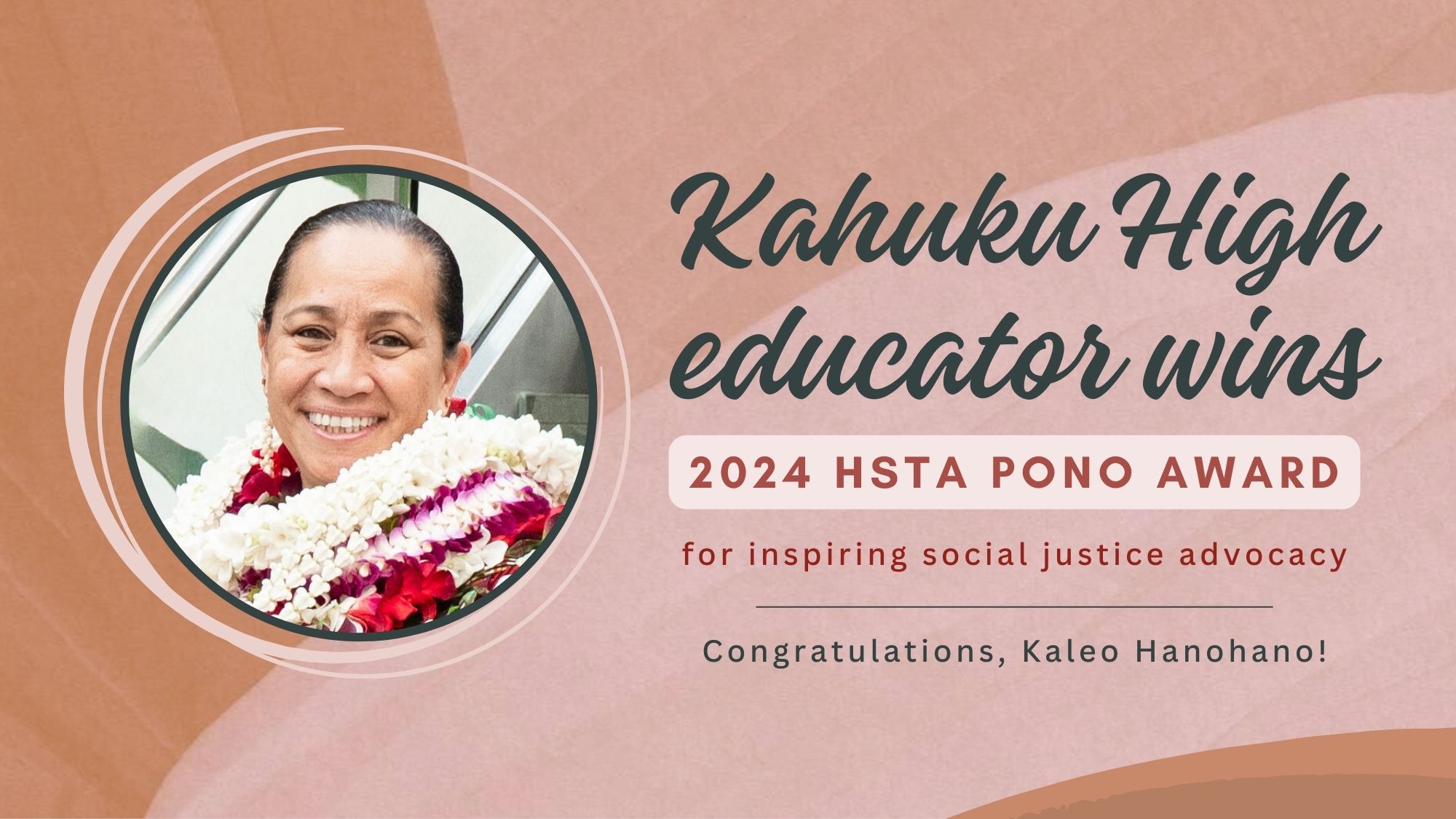Kaleo Hanohano honored for building connection, kuleana in youth and their community
Posted: May 2, 2024
In 1992, Kaleo Hanohano had just been offered a position to teach Hawaiian language and Hawaiian history at Roosevelt High School.
While sharing the news with her grandmother by phone, Hanohano recalled, “She began to weep. See in her mind, Roosevelt was the best because only the best in English learning could attend in her time. So to have a granddaughter become a teacher there washed over her like a tidal wave. In that instance, she knew some kind of change was happening.
“However, the fear set in. I could hear it in the tone in her voice. She then told me three things I must do to find my place, and make my way through this new setting without losing myself and feeling alone,” Hanohano said.
Those lessons from Hazel Akepamaikalani Akim Naone, a respected educator herself, guided Hanohano’s journey at Roosevelt High, then at Kaimukī High, and now at Kahuku High and Intermediate, where she works to ensure education perpetuates indigenous place-based learning and sustainable practice.
Hanohano’s efforts and impact prompted the Hawaiʻi State Teachers Association to present her with the 2024 Pono Award, which recognizes an exceptional HSTA member who advocates for social justice issues that impact the lives of students, fellow educators, and the community. Her advocacy and teaching ensure our youth gain and perpetuate a sense of Hawaiʻi, connection, and kuleana for generations to come.
Lessons from Granny
In her acceptance speech, delivered April 13 at the Hawaiʻi Convention Center before hundreds of fellow educators from across the state, Hanohano shared her grandmother’s lessons, how they fueled her approach to education, and led to many social justice wins throughout her teaching career.
- Make friends. Connect with people in your school. Start with the custodians, cafeteria workers, librarians and those who want to participate in things that interest you. Make friends with everyone and share aloha, even when it seems they are not interested.
- Get to know your community. Make their neighborhood your neighborhood, and seek out the elders with ʻike kupuna who want to share with you their specific knowledge. Encourage folks to partner with you and to see the potential for future learning, collaboration, and collective adventure.
- Share your talents. Make sure to share your gifts, especially those gained from mentors, and those perfected over time.
“Social justice and change is not impossible. In fact, it is our kuleana,” Hanohano said. “You may think you’re just one person. You may think you’re replaceable. But your work is not.”
Starting over
Hanohano began teaching at Kahuku High and Intermediate in 2020, during the pandemic. She found herself struggling to adjust.
“It was truly a lonely time for me. I think I spoke to three, maybe four, people on campus that whole year. I was familiar with my work, but not familiar with the school or the space. I was scared and began doubting my purpose,” she said.
As restrictions eased and her confidence returned, Hanohano reflected on her grandmother’s lessons and began with step one: making friends. That’s when she noticed one of her colleagues was out sick.
“When she returned, I asked if I could lend support and maybe bring our Hawaiian year two, three, and four classes together to participate in PIKO (connection) and practice protocol. She was thrilled with the idea,” Hanohano said.
Creating change in the community
Over the 2022–2023 school year, the Hawaiian language program met weekly for PIKO, and the collaboration grew to include the sharing of vocabulary building tools and conversational exercises. Hanohano tracked and showcased their work, building a chronological story board backed by data. Their professional learning community (PLC) began to collect common formative assessments and met regularly to set and tackle priorities.
Their plans expanded even more for the following school year.
“We put together a gigantic effort to join forces to re-envision the Hawaiian language program as a thriving academy,” Hanohano said. With grants from the Hawaiʻi State Department of Education’s Office of Hawaiian Education, “we developed classroom norms, language competencies and scaffolding with an ʻāina-based focus on ahupuaʻa restoration and resource sustainability.
“Our plans were large. They were unrealistic; an idea no one else would want to do,” Hanohano said.
But the team persevered, connecting with community partners and local farmers to organize huakaʻi, or field trips, in the koʻolauloa area — an opportunity the students didn’t have before as a Hawaiian language academy.
“This synergy encourages kuleana between peers. It galvanizes their kuleana to ʻāina, to ʻohana, to the community, and then to their lāhui, or people,” Hanohano said.
Their efforts paid off. Over nine months, the PLC took 785 students to learn about their moku, or district, from the kupuna elders in their community. And in late April, Hanohano accompanied her students on a field trip to ‘Iolani Palace and the Hawaiʻi State Legislature, where they were recognized by their lawmakers.
Now, the number of students looking to enter Kahuku High and Intermediate’s Hawaiian language program has doubled at all levels. The school is currently looking at ways to accommodate all the requests.
Hanohano encourages all educators to bring the power of PIKO to every student in Hawaiʻi.
“Together, we have power. Create a situation where you can return to the work and ask how you can repeat this work wherever you go. Being a pono leader is to build something lasting in the community that will have an impact long after you leave,” Hanohano said.



